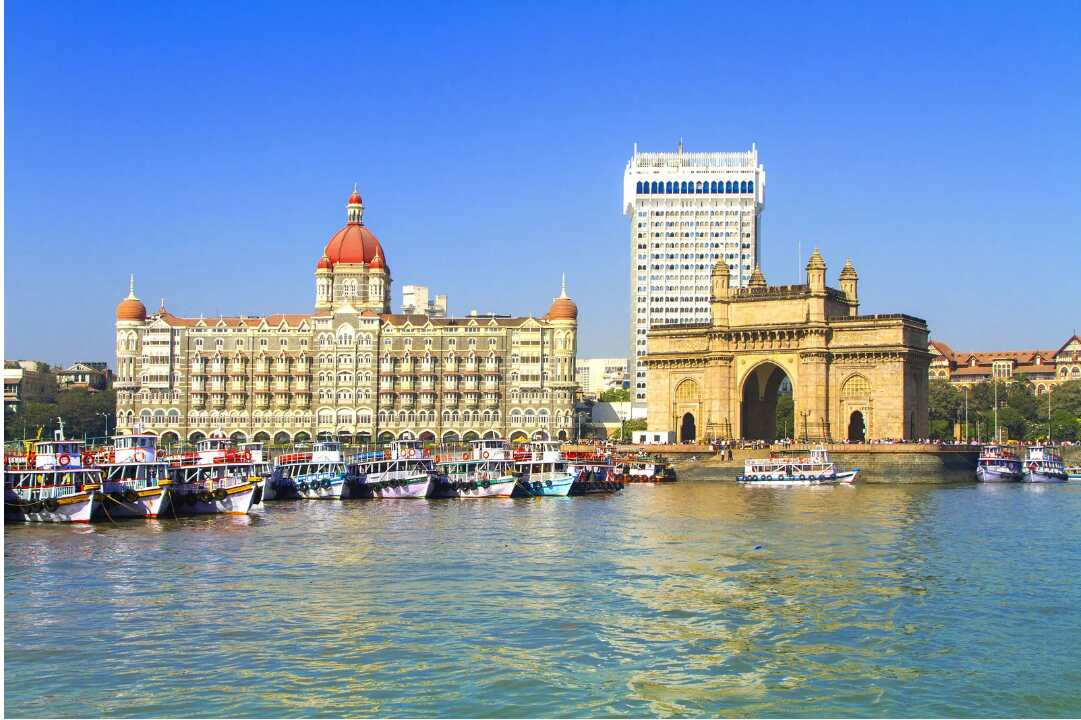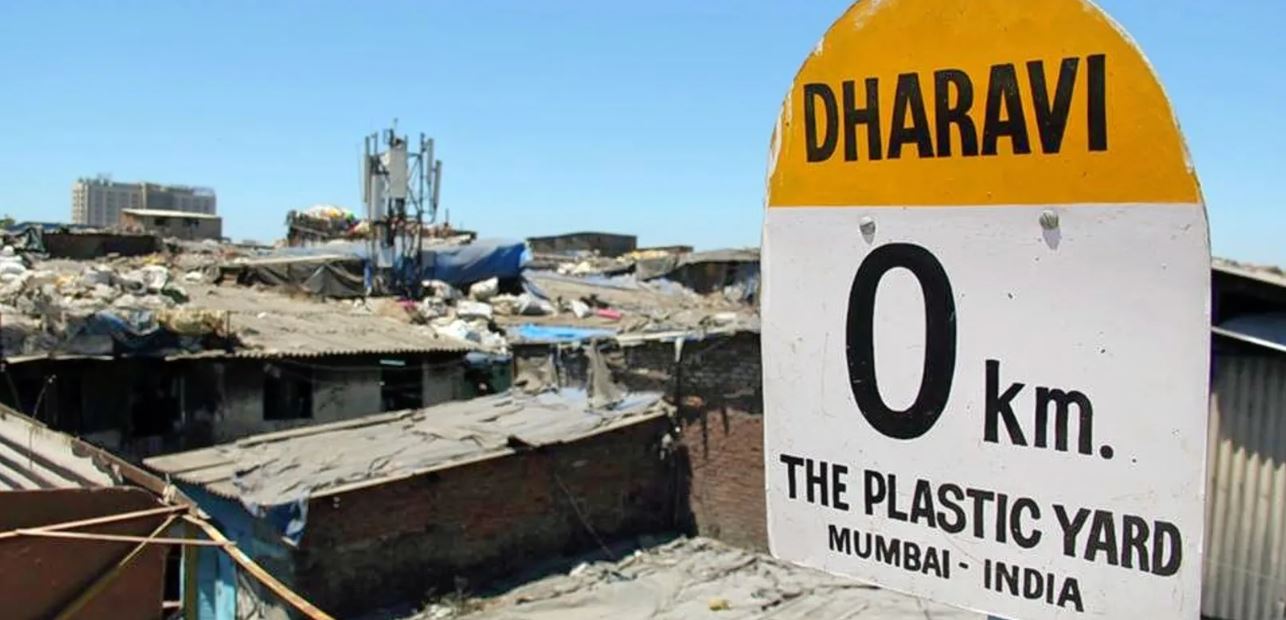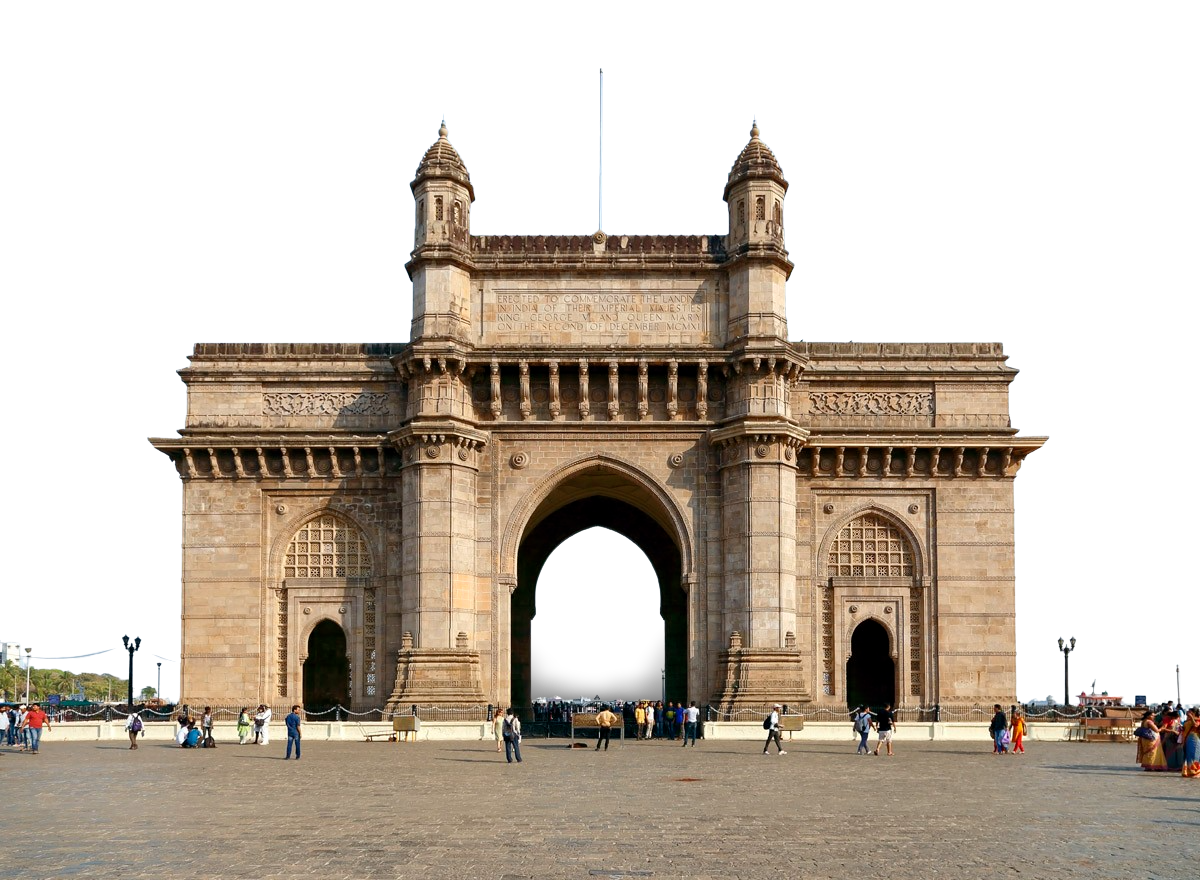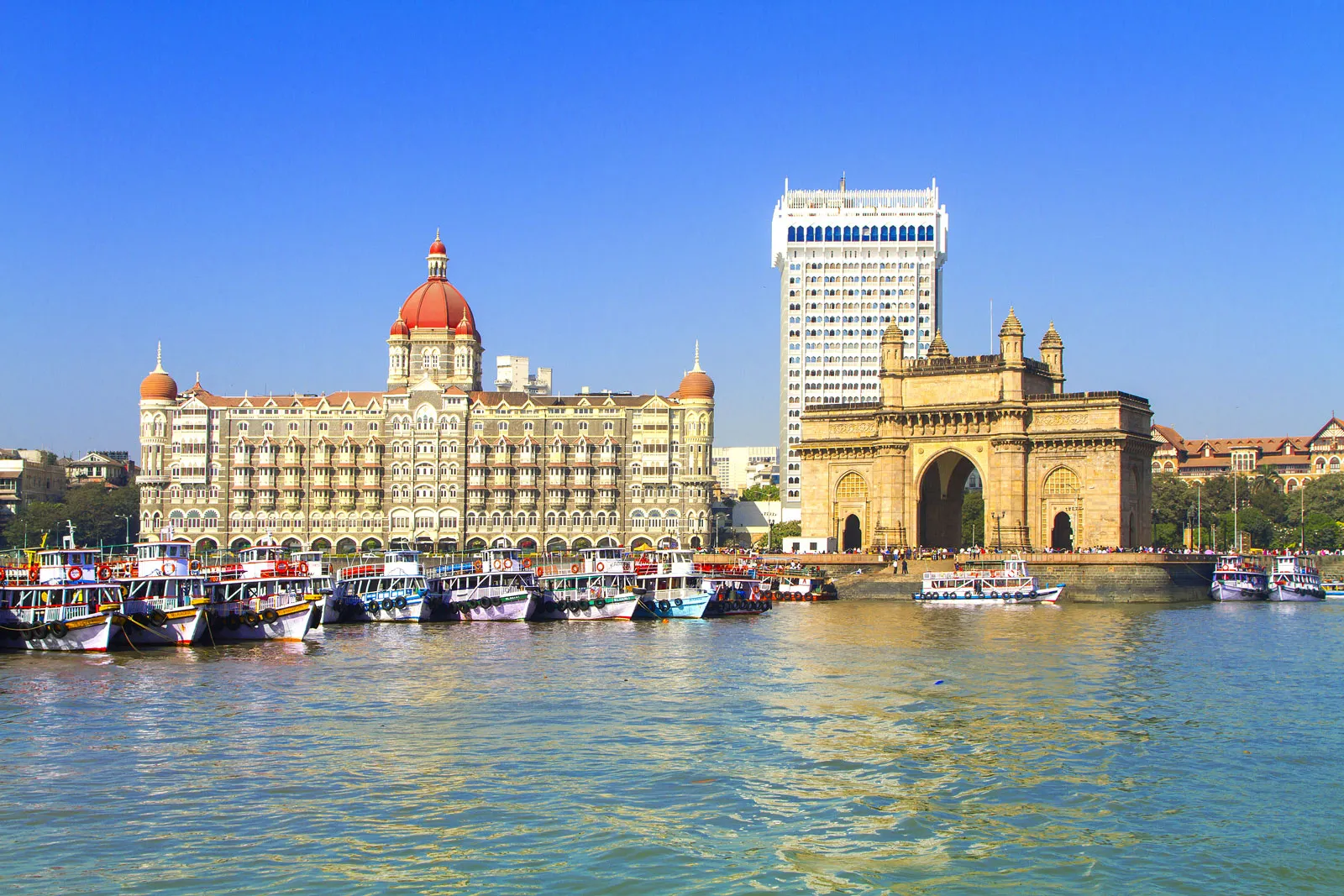Mumbai is a bustling, exciting city of some 20 million people. It is India’s financial capital and the centre of India’s thriving entertainment industry known as ‘Bollywood’. Mumbai once was a group of 7 islands that were reclaimed in a civil project called Hornby Vellard and now forms a peninsula with a spectacular bridge over the sea linking South Mumbai with its famous suburb of Bandra. Every corner of every street of this lively city is fascinating and creating a list of must-see attractions is a tall order! Nevertheless, no matter how long or short your stay in Mumbai is, these are sites not to be missed:
- Gateway of India
The Gateway of India is an arch-monument built in the early twentieth century by the British to commemorate the visit of the royal couple King George and Queen Mary. At the time of the royal visit the monument had not been constructed, so instead a replica of cardboard was used to greet the Monarch.
The first stone was laid by the Governor of Bombay on March 31st, 1913. It is constructed in Indo-Saracenic architectural style and designed by George Wittet. It opened to the public in 1924 and the 26-meter tall arch became the symbol of the British Raj in India. On 28th Feb 1948, the last British troops, the Somerset Light Infantry, departed from here under the guard of honour of the newly formed Indian army.
Today, The Gateway of India serves as the landmark and an iconic site of Mumbai. It is not only international tourists who visit – it is also on the agenda of the many thousands of Indian tourists who visit Mumbai each year. From the Gateway of India, you can also take a ferry to the Elephanta caves situated on a small island.
- Chhatrapati Shivaji Terminus (former Victoria Terminus)
Chhatrapati Shivaji Terminus is one of the biggest train stations in India. Built-in 1888, the station is a monument to Gothic architecture. It was designed by British architectural engineer Frederick Willam Stevens and was named Victoria Terminus. Before designing the station Frederick William spent ten months in Europe researching Gothic architecture, eventually drawing inspiration from Saint Pancras station in London.
In 1995 the station was renamed from Victoria Terminus to Chhatrapati Shivaji Terminus in honour of the emperor Chhatrapati Shivaji who was the founder of the Maratha empire. On 2nd July 2004, it was declared as a World Heritage site by the World Heritage Committee of UNESCO. Every day more than 3.5 million people commute from this station. There are 18 platforms in this station and if you have watched the Oscar-nominated film Slumdog Millionaire you will see that the last song “Jai ho” was filmed on one of the platforms in the station.
At the time of the construction, a marble statue of Queen Victoria was installed below the clock on the main building. But, after independence, most of the statues of the British figures were removed from the government buildings and public properties. A lot of the statues were shifted to Victoria Garden situated in south Mumbai but Queen Victoria’s statue from the station wasn’t one of them. Some say it has been exported out of India and some say it must be sold by the Government and some historians say it must have been destroyed. Chhatrapati Shivaji Terminus was one of the affected places of the terrorist attack on 26th November 2008. A group of 10 terrorists attacked some of the prominent buildings in Mumbai. Bullets from AK-56 rifles have damaged some of the parts of the heritage station.
- Dhobi Ghat
Mahalaxmi Dhobi Ghat has become a very important tourist destination. It is famous as the biggest open-air laundry in the world. It is said that they wash approximately 200,000 clothes each day! The clothes are from small hotels, hospitals, Spas, garment manufacturing units and also local laundry shops. People working here are migrants from north India, working for their bosses who rent washing cubicles from the government. Dhobi Ghat was built in the latter half of the 19th century by the British to wash the dirty linens of the soldiers. In 2011 it was registered in the Guinness book of world record under the “most people hand-washing clothes at a single location”.
The entire washing service takes 24 hours. Dirty clothes arrive from various places, they are then segregated and coded to keep track of where they come from and where they need to be delivered again after washing. The clothes are then soaked in soapy water and flogged on stone. The clothes are then dried in the sun and ironed before sending them back to their final destination. It is free to watch Dhobi Ghat from a viewing point above the laundry, but if you want to visit inside Dhobi Ghat it is best to hire a tour service or a guide who will take you on a proper tour.
- Dharavi Tour
For outsiders, Dharavi is one of the biggest slums in the world, but in reality, it is a city within a city. The population of Dharavi is approximately 1 million. The inhabitants are as same as anyone else in the city because 45 per cent of the Mumbai population lives in a slum. The origin of slums in Mumbai dates back 200 years when people first began to come to the city for work. With no adequate housing, large areas were utilised for building shanty houses which we now call slums.
Dharavi has now developed into a commercial slum in which there are around 10,000 small scale businesses contributing in the region of $665 million to $1 billion. Businesses such as manufacturing leather, textile, plastic recycling, food making and pottery industries have developed in Dharavi creating its reputation as an “entrepreneurial slum”. As well as businesses, Dharavi is extremely diverse with and home to people of 6 religions and 30 languages. The morning in Dharavi starts with the first call for prayer in the Mosque and ends the day with the harmonious sound of a bell ringing in the temple. To experience the life and spirit of the people in Dharavi, you really need to come with us on our Dharavi slum tour.
- Rajabai Clock Tower
Rajabai Tower is a world heritage site situated on the premises of Mumbai University. It is modelled on Big Ben in London and constructed in Venetian and Gothic style architecture. It is 280ft tall, which is equivalent to a 25 storey building. During the construction, a portion of the total cost of construction was donated by Premchand Roychand, a prosperous broker who founded the Bombay Stock Exchange, on the condition that the tower was named after his mother “Rajabai”. Premchand Roychand’s mother was blind and as a staunch follower of Jain religion, she had her evening meal before sunset. Legend says that the evening bell of the tower helped her to grasp the time without anyone’s help.
- Crawford Market
Built-in 1896, Crawford market is the oldest market in Mumbai. It was named after the first Municipal Commissioner of the city, Auther Crawford. As well as being the oldest market in Mumbai, it has another claim to fame. Crawford Market was the first place in India to use electric lighting.
In 1995, like Victoria Terminus train station, even this market’s name changed to Mahatma Jyotiba Phule Mandai. The market has different sections such as fruits, vegetables, spice shops and butchers’ houses. The market is beautifully designed in colonial architecture and has beautiful fountains designed by Lockwood Kipling. The market is open all day, but to get the best experience visit in the morning.
Opposite Crawford Market, you will find Mangaldas Market, which is the oldest textile market in Mumbai. You can comfortably walk through this market even if you are not purchasing anything, but it is a fun market to try out your bargaining skills!
- Mani Bhavan
Mani Bhavan is a historical building where Mahatma Gandhi stayed in Mumbai between 1917 and 1934. The house belonged to Gandhi’s friend and it was from this property that Gandhi led the civil disobedience movement and Satyagraha. This was the same building from where Mahatma Gandhi was arrested by the British in 1932. After Gandhi’s death, the house was converted into a museum. The first two floors have a library with 40,000 books about Mahatma Gandhi, a photo gallery and newspaper cuttings about Gandhi’s life. The upper floor houses Gandhi’s personal room which has been preserved as he left it. There is also a storytelling walk told through miniatures.
Mani Bhavan is a walkable distance from Charni road train station on the western line. Within easy reach of Mani Bhavan, the Babulnath temple, ISKCON temple and Girgaum Chowpatty (Beach) are all worth a visit.
- BanGanga Tank
BanGanga Tank is one of the most interesting and offbeat sites in Mumbai. It is an ancient holy water tank with an underground freshwater spring. It is believed that the water spring was created by the arrow Lord Rama fired when he and his army were thirsty on the journey to rescue his wife from the demon king, Ravana. This ancient tank was built in the 12th century by the Hindu Silhara dynasty but the spring water source has existed for thousands of years. It is considered a Holy tank and the water has healing powers.
- Hanging Garden
One of the most fantastic places in Mumbai is called Kamala Nehru park, which is famously known as the Hanging Gardens. This park was built in 1952 under the initiative of Pandit Jawaharlal Nehru, the first prime minister of India. He built this park with the purpose of showing his love of children and paying homage to his beloved wife by naming it in her honour. The park makes the old nursery rhyme come true with a massive shoe for kids to play with!
One of the best parts of the park is the stunning gallery view over the city.
10. Haji Ali Mosque
Haji Ali mosque is a most interesting religious site in Mumbai. Many people call it a floating mosque because when the tides are high covering the path to the mosque, it looks like it is floating. It was built in 1431 by the devotees of Pir Haji Ali Shah Bukhari. A well-known story of Pir Haji Ali tells of his encounter with a woman crying outside his house. She told him she was crying because she had accidentally spilt the oil she was carrying and her husband would thrash her as he was a very cruel man. Haji Ali felt very sad for her and decided to help her. He pressed his finger into the soil and the oil gushed out. The overjoyed woman filled up the vessel and went home. Later, Pir Haji Ali had a recurring and disturbing dream that he had injured Earth by his act.
Pir Haji Ali advised his followers that when he died his body should not be buried, but instead should be kept in the casket and sent out to sea. He wished to be buried at the point the casket stopped. The casket miraculously stuck into the rocks and that is why his followers buried him there and built a tomb.
11) Jain Temple
Jainism is one of the smallest religions in India with approximately 4.5 million followers. Jainism is an offshoot of Hinduism which promotes vegetarianism and non-violence. This religion also restricts eating root fruits and vegetables because an individual has to kill the entire plant to eat them. the most thing that creates Jainism unique is it’s an atheist religion that believes in 24 Thirthankars who were the Holy wise people of Jainism. But if you visit the temple, you may find that culturally it’s very like Hinduism. A Jain temple is generally built with white marbles and stone carvings. The architecture and peace inside the temple are beautiful, although not everyone seems to be permitted to enter the temple.
Below are the foundations to follow.
- One mustn’t take any footwear (including socks) inside the temple. Leather items sort of a belt, purse etc. doesn’t seem to be allowed inside the temple premises.
- One mustn’t be chewing any edibles (food, gum, mints, etc.), and no edibles should be stuck within the mouth.
- Non-Jain people cannot enter the praying area of the temple. you’re only allowed within the premises.
- Before entering the temple, one should bathe and wear freshly washed clothes or some special puja (worship) clothes – while wearing these one must neither have eaten anything nor visited the washroom. However, drinkable is permitted. ( this rule is for Jain those that come for prayers, but it’s good to follow their rules).
12) Elephanta caves
A Unesco World Heritage Site that dates back to 600 AD, Elephanta Caves are a must-see destination if you’re fascinated by archaeology. The Elephanta caves are a set of cave temples dedicated to the Hindu god Shiva. The caves are made from rock-cut stone sculptures. the most temple and therefore the orientation of the cave are in a very Mandala pattern. it absolutely was named ‘Elefante’ by the colonial Portuguese as they found Elephant statues within the caves. The monument was restored in 1970 and was designated a UNESCO world heritage site in 1987.
13) Chor Bazar
This is a famous thieves market of Mumbai which is locally called Chor Bazar. There are many stories about this market and that i can share with you one among the foremost interesting ones. they assert once Empress visited Mumbai and he or she found that her precious violin went missing from her luggage. after they had a radical search, it had been found here during this market and since then it’s called thieves market. But, after all, Empress never visited India. Whoever invented this story, must have done so to entertain people.
The reality is, this market wont to be simply called Shor Bazar which implies a loud market. But, land mispronounced the word Shor as Chor which changed the meaning completely. you’ll be able to have a pleasant go into this market on Mutton Street where the foremost antique shops are. you’ll find lots of old restored items which are definitely worth looking up.
14) Bombay Panjrapole
Bombay Panjrapole is the biggest cow shelter in Mumbai. it had been established in 1934 with the aim of the welfare and nurture of the cow. The cow has been considered a holy animal in India since precedent days because of its ability to contribute most to human lives and occupations. People in India worship cows and thank her for all the great things received from them. this can be not a tourist destination, but a neighbourhood place where people come here to feed the cows and find blessings from her.
15) Dabbawala
The most efficient organisation on Earth are the Dabbawallas. Simply, it’s an organisation that gives the service of memorizing people’s home-cooked lunch boxes from their homes and delivering them to their workspace to serve fresh warm food. Dabbawalas have mastered supply chain management so well that they deliver approximately 200,000 lunch boxes every day with zero technology and with no sophisticated logistics management systems.
In 1998, Forbes Global magazine gave a six sigma efficiency rating because their error ratio was 1 in every 16 million deliveries with an accuracy of 99.999 per cent. Many management schools visit Dabbawalas to review their operations and the university made a case study about them. Their operations became a famous attraction in Mumbai not only for tourists but also for several famous personalities like Prince Charles, Richard Branson and Dutch Queen Maxima. you’ll be able to spot them opposite Churchgate railway station between 11.30 – 12.00 pm.
India is a beautiful country with enormous history and culture. People in India are really welcoming with some great smiles on their faces and values rooted deep, as we believe in manifesting our tourism slogan “Atithi Devo Bhava” which translates as “the guest is God”.
We help travellers to find their perfect boundless vacation with the pride and satisfaction of contributing towards a noble cause of empowering women in India.
You will experience an insightful understanding of the city’s rich history, culture, and lifestyle led by our friendly English-speaking female tour guide (who also is the brand ambassador of our organisation).
To know more about us or our tours & experiences in Mumbai, kindly send us an enquiry.





